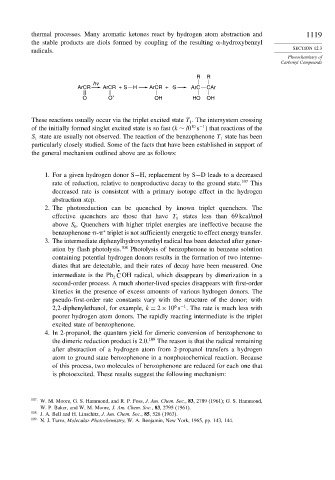Page 1134 - Advanced Organic Chemistry Part A - Structure and Mechanisms, 5th ed (2007) - Carey _ Sundberg
P. 1134
thermal processes. Many aromatic ketones react by hydrogen atom abstraction and 1119
the stable products are diols formed by coupling of the resulting -hydroxybenzyl
radicals. SECTION 12.3
Photochemistry of
Carbonyl Compounds
R R
hv .
.
ArCR ArCR + S H ArCR + S ArC CAr
∗
O O OH HO OH
These reactions usually occur via the triplet excited state T . The intersystem crossing
1
10 −1
of the initially formed singlet excited state is so fast (k ∼ l0 s ) that reactions of the
S state are usually not observed. The reaction of the benzophenone T state has been
1
1
particularly closely studied. Some of the facts that have been established in support of
the general mechanism outlined above are as follows:
1. For a given hydrogen donor S−H, replacement by S−D leads to a decreased
rate of reduction, relative to nonproductive decay to the ground state. 107 This
decreased rate is consistent with a primary isotope effect in the hydrogen
abstraction step.
2. The photoreduction can be quenched by known triplet quenchers. The
effective quenchers are those that have T states less than 69 kcal/mol
1
above S . Quenchers with higher triplet energies are ineffective because the
0
∗
benzophenone - triplet is not sufficiently energetic to effect energy transfer.
3. The intermediate diphenylhydroxymethyl radical has been detected after gener-
ation by flash photolysis. 108 Photolysis of benzophenone in benzene solution
containing potential hydrogen donors results in the formation of two interme-
diates that are detectable, and their rates of decay have been measured. One
•
intermediate is the Ph C OH radical, which disappears by dimerization in a
2
second-order process. A much shorter-lived species disappears with first-order
kinetics in the presence of excess amounts of various hydrogen donors. The
pseudo-first-order rate constants vary with the structure of the donor; with
6 −1
2,2-diphenylethanol, for example, k = 2×10 s . The rate is much less with
poorer hydrogen atom donors. The rapidly reacting intermediate is the triplet
excited state of benzophenone.
4. In 2-propanol, the quantum yield for dimeric conversion of benzophenone to
the dimeric reduction product is 2.0. 109 The reason is that the radical remaining
after abstraction of a hydrogen atom from 2-propanol transfers a hydrogen
atom to ground state benzophenone in a nonphotochemical reaction. Because
of this process, two molecules of benzophenone are reduced for each one that
is photoexcited. These results suggest the following mechanism:
107
W. M. Moore, G. S. Hammond, and R. P. Foss, J. Am. Chem. Soc., 83, 2789 (1961); G. S. Hammond,
W. P. Baker, and W. M. Moore, J. Am. Chem. Soc., 83, 2795 (1961).
108 J. A. Bell and H. Linschitz, J. Am. Chem. Soc., 85, 528 (1963).
109
N. J. Turro, Molecular Photochemistry, W. A. Benjamin, New York, 1965, pp. 143, 144.

